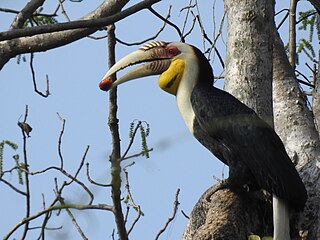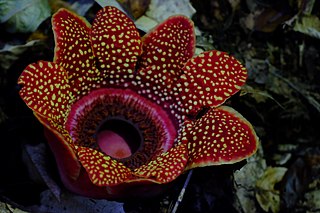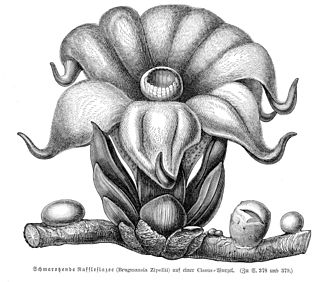
Rafflesia, or stinking corpse lily, is a genus of parasitic flowering plants in the family Rafflesiaceae. The species have enormous flowers, the buds rising from the ground or directly from the lower stems of their host plants; one species has the largest flower in the world. Plants of the World Online lists up to 41 species from this genus, all of them are found throughout Southeast Asia.
The Lisu people are a Tibeto-Burman ethnic group who inhabit mountainous regions of Myanmar (Burma), southwest China, Thailand, and the Indian state of Arunachal Pradesh.

The Namdapha flying squirrel is a flying squirrel endemic to Arunachal Pradesh in northeast India, where it is known from a single zoological specimen collected in Namdapha National Park in 1981.

The back-striped weasel, also called the stripe-backed weasel, is a weasel widely distributed in Southeastern Asia. It is listed as Least Concern on the IUCN Red List in view of its presumed large population, occurrence in many protected areas, apparent tolerance to some degree of habitat modification and hunting pressure.

The wreathed hornbill is an Old World tropical bird of the hornbill family Bucerotidae, also called bar-pouched wreathed hornbill due to its distinctive blue-black band on its lower throat sac. It is named after its characteristic long, curved bill that develops ridges, or wreaths, on the casque of the upper mandible in adults. Males are black with a rufous crown, a white upper breast and face, and a yellow featherless throat. Females are uniformly black with a blue throat and are slightly smaller than males.

The Rafflesiaceae are a family of rare parasitic plants comprising 36 species in 3 genera found in the tropical forests of east and southeast Asia, including Rafflesia arnoldii, which has the largest flowers of all plants. The plants are endoparasites of vines in the genus Tetrastigma (Vitaceae) and lack stems, leaves, roots, and any photosynthetic tissue. They rely entirely on their host plants for both water and nutrients, and only then emerge as flowers from the roots or lower stems of the host plants.

A parasitic plant is a plant that derives some or all of its nutritional requirements from another living plant. They make up about 1% of angiosperms and are found in almost every biome. All parasitic plants develop a specialized organ called the haustorium, which penetrates the host plant, connecting them to the host vasculature – either the xylem, phloem, or both. For example, plants like Striga or Rhinanthus connect only to the xylem, via xylem bridges (xylem-feeding). Alternately, plants like Cuscuta and some members of Orobanche connect to both the xylem and phloem of the host. This provides them with the ability to extract resources from the host. These resources can include water, nitrogen, carbon and/or sugars. Parasitic plants are classified depending on the location where the parasitic plant latches onto the host, the amount of nutrients it requires, and their photosynthetic capability. Some parasitic plants can locate their host plants by detecting volatile chemicals in the air or soil given off by host shoots or roots, respectively. About 4,500 species of parasitic plants in approximately 20 families of flowering plants are known.

Namdapha National Park is a 1,985 km2 (766 sq mi) large protected area in Arunachal Pradesh of Northeast India. The park was established in 1983. With more than 1,000 floral and about 1,400 faunal species, it is a biodiversity hotspot in the Eastern Himalayas. The national park harbours the northernmost lowland evergreen rainforests in the world at 27°N latitude. It also harbours extensive dipterocarp forests, comprising the northwestern parts of the Mizoram-Manipur-Kachin rain forests ecoregion.

The Eastern Himalayan broadleaf forests is a temperate broadleaf forest ecoregion found in the middle elevations of the eastern Himalayas, including parts of Nepal, India, Bhutan, Myanmar and China. These forests have an outstanding richness of wildlife.

Sapria is a genus of parasitic flowering plants in the family Rafflesiaceae. It grows within roots of Vitis and Tetrastigma. The genus is limited to the tropical forests of South and Southeast Asia.

Plectocomia is a genus of flowering plant in the family Arecaceae native to China, the Himalayas, and Southeast Asia. Plants are dioecious, with male and female flowers produced on separate individuals.

The Eastern Himalayan alpine shrub and meadows is a montane grasslands and shrublands ecoregion of Bhutan, China, India, Myanmar, and Nepal, which lies between the tree line and snow line in the eastern portion of the Himalaya Range.

Clerodendrum glandulosum, commonly known as East Indian glory bower, is a perennial shrub belonging to the family Lamiaceae, but sometimes classified under Verbenaceae. It is one of the most well known among ~400 species of Clerodendrum, as it is widely used in traditional practices, such as for vegetable and treatments of diabetes, hypertension, cough and rheumatism.

Rhizanthes is a genus of four species of parasitic flowering plants in the family Rafflesiaceae. They are without leaves, stems, roots, or photosynthetic tissue, and grow within the roots of a few species of Tetrastigma vines. The genus is limited to the tropical forests of Southeast Asia. The flowers of Rhizanthes are very large, they vary from 14 to 43 cm in diameter. At least one species of Rhizanthes, Rh. lowii, is endothermic.
Rhizanthes lowii is a species of parasitic flowering plant without leaves, stems, roots, or photosynthetic tissue. It grows on the roots of the Tetrastigma vine. It includes the specimens with the largest measured flowers in Rhizanthes, from 25 to 43 cm across. The flowers are endothermic, not only producing their own heat, but they also have the rare ability to regulate their own temperature.
Rhizanthes deceptor is a species of parasitic flowering plant without leaves, stems, roots, or photosynthetic tissue. They grow on roots of the Tetrastigma vine. They are only found in the tropical forests of Sumatra at 500–700 m. The flowers are white, with red-brown tips, and are from 20 to 27 cm across.
Rhizanthes infanticida is a species of parasitic flowering plants without leaves, stems, roots, or photosynthetic tissue. They grow on roots of the Tetrastigma vine. They are found in the tropical forests of southern Thailand, western Malaysia, and Sumatra. The brown flowers are from 14 to 22 cm across. The flowers smell like a mammalian carcass and attract flies, which pollinate the blooms while laying their eggs inside. The flies' larvae die due to the lack of nutrients, hence the species name "infanticida".
Rhizanthes zippelii is a species of parasitic flowering plant without leaves, stems, roots, or photosynthetic tissue. Its flowers bud out of the roots of the Tetrastigma vine. It is found in the tropical rainforests of Java. The flowers are reddish-brown, with long hanging tips, and are from 12 to 29 cm across.

Vijaynagar is the most remote town and circle headquarters in the Changlang district, Arunachal Pradesh, India.

Arunachal Pradesh is primarily a hilly tract nestled in the foothills of the Himalayas in northeast India. It is spread over an area of 83,743 km2 (32,333 sq mi). 98% of the geographical area is land out of which 80% is forest cover; 2% is water. River systems in the region, including those from the higher Himalayas and Patkoi and Arakan Ranges, eventually drain into the Brahmaputra River.
















